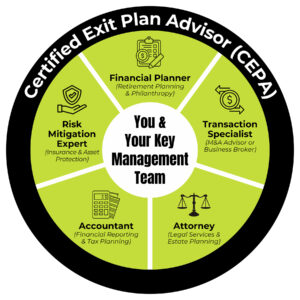
Fall brings crisp air, colorful leaves, and the undeniable excitement of football season. And much like football, where great individual players exist, the game’s heart and soul lie in teamwork. No matter how talented a quarterback or running back is, they can’t win the game alone. Victory requires everyone—linemen, defense, special teams, and coaches—working together toward a shared goal.
Succession and exit planning for business owners are strikingly similar. Just as a quarterback can’t win without a strong team, an owner can’t craft a successful exit strategy solo. Many owners are so wrapped up in running their day-to-day operations that they never stop to think about their “end game.” And like a team without a playbook, they often delay these crucial conversations until it’s too late.
According to the first-ever “2024 State of Succession and Exit Planning in the Horticulture Industry” survey by PivotPoint Business Solutions, we’re seeing too many businesses fumble the ball. The data shows an alarming trend of closures and liquidations—avoidable with proper planning. Succession planning, like football, is a team sport, and many businesses are unprepared for the big win.
Ideally, business owners start with the end in mind. But the survey reveals that our readiness score as an industry is a mere 3 out of 10. Even worse, 32% of respondents don’t have an exit plan at all, and of those wanting to exit within two years, 55% haven’t started preparing. The message is clear: You can’t do it alone.
Building Your Winning Team
In football, every successful team needs coaches and players making the right moves to cross the goal line. For a business owner, your trusted advisors are your coaching staff, and they play an equally pivotal role in guiding you to a successful exit. Creating a well-structured exit plan that maximizes your business’s value can take 3-5 years, but with the right team, you’ll be prepared for anything—from an unexpected third-party offer to a forced exit due to unforeseen events like death, disability, divorce, business disagreements between owners, or business distress.
So, who are the key players on your exit planning team, and how do they help you score the winning touchdown?
Your Trusted Advisors: The Coaching Staff
Just like in football, you need a variety of coaches or experts working in harmony to achieve success. Here’s a breakdown of the key advisors every owner should have:
The Accountant (CPA):
Often the most trusted advisor, your accountant knows your financial history inside out. They ensure clean financials, which are crucial for any exit plan. Survey results show that 25% of respondents rely on their accountant the most.
The Attorney:
Your legal coach is critical in drafting key agreements like Shareholder and Buy-Sell for example, and reviewing any Letters of Intent or offers. With 17% of respondents citing their attorney as a top advisor, their role in securing the “game-winning” contracts and estate planning is indispensable.
The Financial Planner:
Only 12% of business owners look to their financial planner for guidance, but they should. Financial readiness is a key factor in your transition. In fact, 70% of owners are unsure of their after-tax income needs post-transition. Many owners face financial uncertainty, rating their financial readiness 58 out of 100, well below our target of 80. A financial planner helps you plan for retirement, ensuring you have enough resources to live comfortably once you exit.
Certified Exit Plan Advisor (CEPA):
Your CEPA is your quarterback who calls the plays in your business transition. This advisor coordinates all the moving parts, bringing together your personal, business, and financial goals to ensure a smooth exit. Shockingly, only 7% of survey respondents have a CEPA, but they are key to keeping your exit strategy on track.
Your CEPA leads the team through three critical phases:
- Discovery-Understanding your personal goals, business goals, and financial situation, including a business valuation.
- Preparation-Building value, mitigating risks, and setting up your financial future.
- Decision-Guiding you to confidently choose between growing or selling, with everything in place for a smooth transition.
Your Spouse is Not Your Trusted Exit Advisor
The survey found that many owners consider their spouse their most trusted advisor. While it’s wonderful to have that partnership in life, exit planning requires external, specialized guidance. Just as in football, where you likely wouldn’t ask a family member to coach the Super Bowl, you need objective advisors to give you the best shot at success. They will help manage the complex legal, financial, and operational components of your exit.
Your Internal Team: The Key Players
In football, even the best coaches need skilled players to execute the game plan. The same goes for your business. Your internal management team plays a critical role in driving the business forward. Luckily, 80% of survey respondents have already shared their plans with key team members. Regular communication with your team—whether family, employees, or potential successors—is essential to prevent misunderstandings and to align everyone on business goals and timelines.
Just as football teams develop a strategy for each play, you need a plan to retain these key players and keep your business running smoothly as you move toward your transition. Next month we’ll talk more about how to ensure you have the right people on your team and what it takes to retain these key players as you move down your path to victory.
Teamwork Makes the Dream Work
Only 33% of business owners are currently working with advisors to prepare for their exit. But just as no football team can win the Super Bowl with only one star player, you can’t craft an effective exit strategy alone. Exit planning is a team effort that requires insights from multiple stakeholders—advisors, management, and family members. Each brings expertise in a specific area, helping you navigate the transition successfully.
Ultimately, winning in business transition is like winning the big game—it takes teamwork, strategy, and preparation. With the right trusted advisors and players by your side, you’ll be well on your way to securing your business’s legacy and crossing that finish line victoriously.
Chris Cimaglio, CEPA®, Certified Value Builder™, Accredited Value Guide, PEMA® is the Managing Director at PivotPoint Business Solutions. Contact Chris at chris@pivotpointbizsolutions.com.
 A well-defined roadmap is crucial for guiding the exit process. This plan should detail every step, from preparing your business for sale to identifying potential buyers and managing legal and financial aspects. A structured approach ensures that all aspects of the transition are handled efficiently and with minimal disruption.
A well-defined roadmap is crucial for guiding the exit process. This plan should detail every step, from preparing your business for sale to identifying potential buyers and managing legal and financial aspects. A structured approach ensures that all aspects of the transition are handled efficiently and with minimal disruption.



